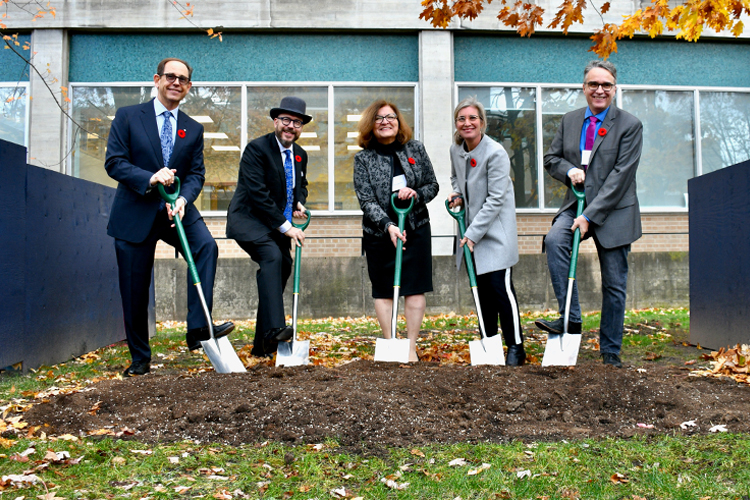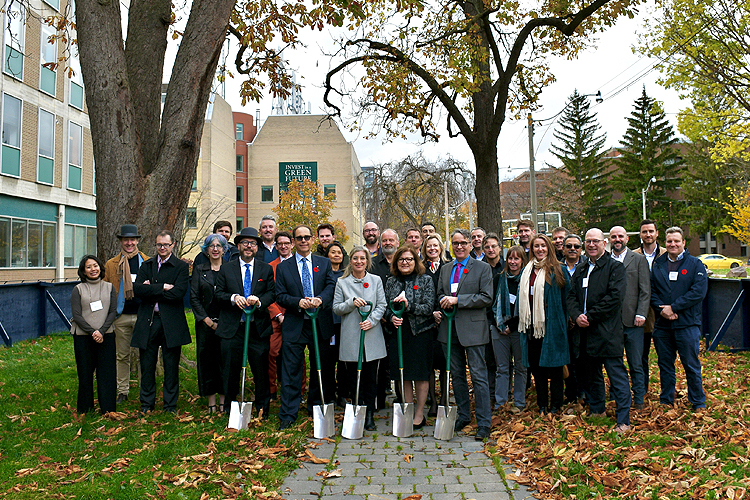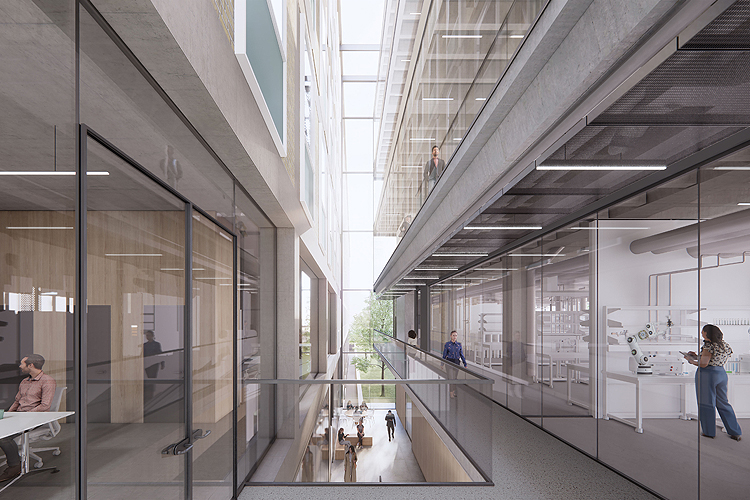Exciting expansion project will enable game-changing research in new materials discovery and solutions to world’s most pressing issues — from climate change to plastics pollution to cancer.
On Nov. 7, faculty and staff from across U of T gathered to celebrate the expansion of the Lash Miller Building on the St. George campus with a special groundbreaking ceremony to mark the start of construction on the new home of the Acceleration Consortium (AC) and improved facilities for the Department of Chemistry.
Launched in 2021, the AC fuses artificial intelligence (AI), robotics, engineering and chemistry to accelerate the design and discovery of new materials. Using self-driving laboratories powered by AI, the AC works to discover materials needed to build a more sustainable, prosperous and healthy future.
“The research being done at the Acceleration Consortium is a cutting-edge approach to materials discovery. Now, more than ever, we need such new technologies to help solve the world's most existential and intractable problems, from climate change to plastics pollution to cancer,” said Melanie Woodin, dean of the Faculty of Arts & Science. “This expansion is truly about advancing the University’s mission of research and teaching excellence.”

In 2023, the University received a grant of $200 million from the Canada First Research Excellence Fund (CFREF), the largest federal research grant ever awarded to a Canadian university, to support the AC’s research.
“Developing such innovative technologies is made possible by the federal government's visionary investment. This grant allows us to do big science, ensuring Canada remains competitive on the international stage,” said Woodin.
The project will also include renovations to the Department of Chemistry, with upgrades being made to labs, classrooms, and faculty and administrative space, providing students and scientists with enhanced facilities for research, learning and innovation.
“I've watched the plans emerge from both the department and the Faculty side, and it's really an amazing project,” said Mark Lautens, chair of the Department of Chemistry. “The self-driving labs are the cornerstone of the AC, but there will be new lecture theatres and some amazing meeting spaces for chemistry that will figure very prominently in the design. Our students will be prepared for the future, regardless of how that future unfolds.”
Former department chair, Robert Batey, also reflected on the origins of the project, the founding of the AC, and the initial success in enlisting Alán Aspuru-Guzik, director of the AC, to spearhead U of T’s efforts in the emerging field of machine-learning-guided materials development.

“This project really has been a long time in gestation. In 2017, we saw an opportunity to take advantage of a nascent and emerging field of science and technology, which is AI and machine learning, and how it might be applied to, and enabled by, chemistry and automation,” said Batey.
The revolutionary work being done at the AC will be key in positioning Canada as a world leader in materials discovery, with its state-of-the-art space that will not only house this important work, but also attract top tier talent.
“The AC building represents a new global era where countries are looking inward while at the same time collaborating with each other,” said Aspuru-Guzik. “We're building a team of people who are going to be able to take advantage of this new space and of the federal grant to move the needle and make Canada the leader in materials discovery.”

The AC also considers and includes contributions from other disciplines of study in its work. “We are very excited that this project is also integrated with Canadian society in such areas as Indigenous scholarship, social sciences, and economics,” said Aspuru-Guzik. “Materials discovery has to do with everything, and impacts society in a very complex way.”
Anna Kennedy, chair of U of T’s Governing Council, acknowledged the impact the AC has already made at the University. “Since its launch, and under the expert guidance of Alán and other brilliant scholars, the AC has solidified itself as one of the University’s most impressive institutional strategic initiatives (ISI) and as the embodiment of the University of Toronto’s capacity to support large-scale, high-impact interdisciplinary research.”
Woodin also noted the importance of philanthropy in leveraging the historic support from the federal government and investment by industry partners.
“Inspired giving by donors will enable us to build a contemporary space that will attract talent that's needed to advance the goals of the Acceleration Consortium, which will have major economic benefits for the Greater Toronto Area and for Canada,” said Woodin.
The Lash Miller Building expansion is set to be completed in the spring of 2026. The complex project is being delivered through an integrated design team led by the University’s Planning, Design & Construction (UPDC) portfolio and a collaboration between Canadian firm Cumulus Architects and Danish firm Mikkelsen Architects, among other firms specializing in key areas of the project design and technical specifications. The construction will be completed by Urbacon.

